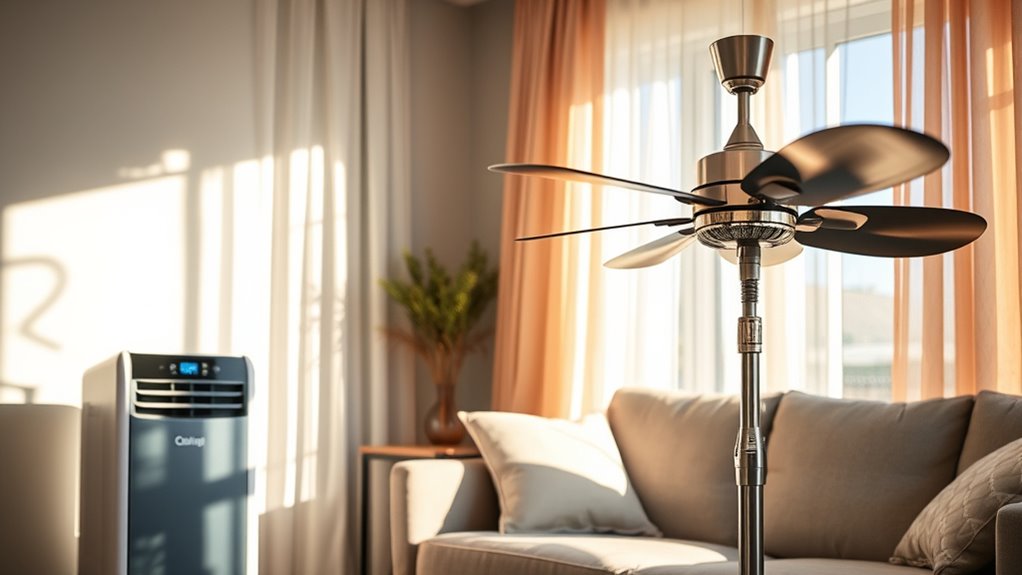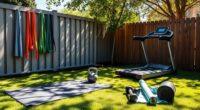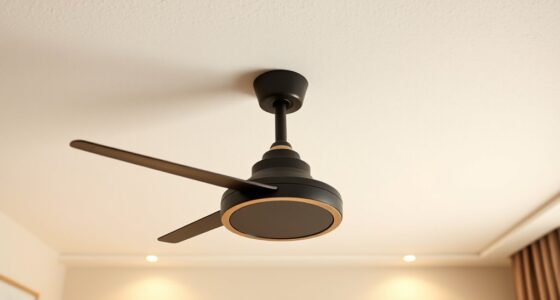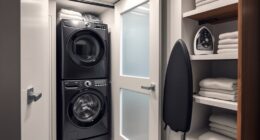If you’re looking for cost-effective comfort, fans are your best bet, using much less energy and freeing you from installation worries. But if you need to cool a large space or reduce humidity, portable ACs work more effectively, though they cost more to operate and are noisier. Your choice depends on your budget, space, and cooling needs. Want to discover which option suits different summer scenarios? Keep exploring for more insights.
Key Takeaways
- Fans are more energy-efficient and cost-effective, making them ideal for long-term, everyday cooling needs.
- Portable ACs provide more effective cooling and humidity control, especially in humid or large spaces.
- Fans are easier to install, move, and maintain, requiring no venting or complex setup.
- Portable ACs produce more noise and require venting, which can limit placement flexibility.
- The choice depends on your cooling needs, space, budget, and preference for convenience versus performance.
Energy Efficiency and Operating Costs
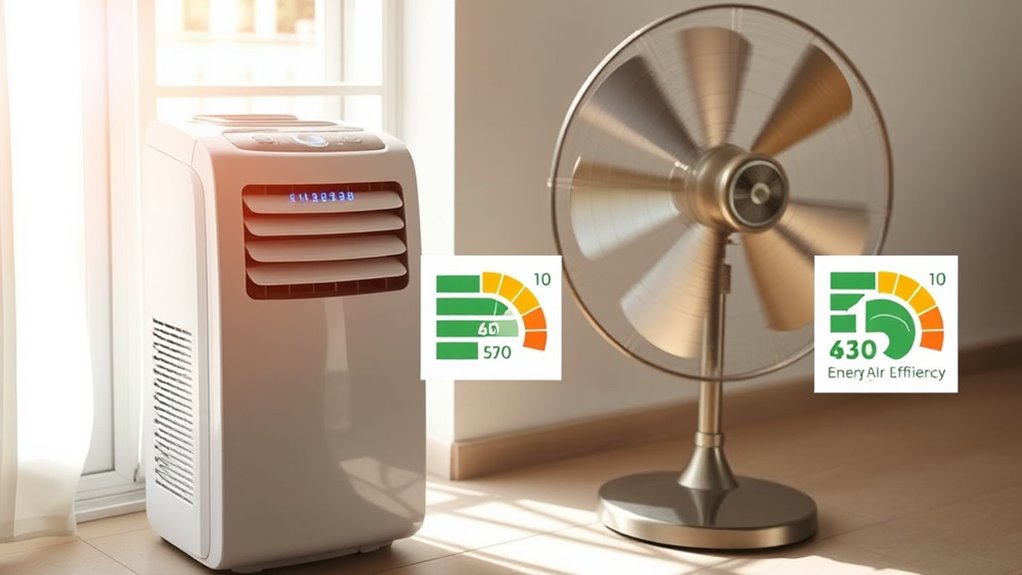
When comparing energy efficiency and operating costs, fans clearly use far less electricity than portable air conditioners. Fans typically consume between 15 to 100 watts, while portable air conditioners range from 500 to 1500 watts per hour. This means fans use about 1% of the energy that air conditioners do, even when running continuously. The monthly cost for a fan is just a few cents, around $0.73, whereas an air conditioner can cost over $20. This significant difference translates to lower electricity bills and a smaller environmental footprint. Fans are simple devices that move air without actively cooling, making them much more efficient and cost-effective for long-term use. Fans consume significantly less energy, which is why they are often recommended for moderate temperatures and energy-conscious households. If saving energy and money is your goal, fans are the clear winner. Additionally, energy-efficient appliances can contribute to reducing overall household energy consumption and promote sustainable living.
Cooling Effectiveness and Functionality

When it comes to cooling effectiveness, portable air conditioners actively lower room temperatures by removing heat, making them more suitable for larger or enclosed spaces. Fans, on the other hand, mainly improve personal comfort through airflow without considerably changing the room’s temperature. Additionally, portable ACs help control humidity levels, while fans and air coolers influence moisture differently, affecting overall comfort depending on your environment. Portable ACs utilize refrigeration technology to deliver more consistent and powerful cooling, which is especially beneficial in humid or large areas.
Heat Removal Capability
How effectively a device removes heat from a room determines its cooling performance. Portable air conditioners use a refrigeration cycle to extract heat from indoor air and exhaust it outside, considerably lowering room temperature. They are designed to handle enclosed, humid environments and can cool large spaces more efficiently than fans. Fans, on the other hand, don’t remove heat; they only circulate air, making you feel cooler through evaporation on your skin. They are ineffective at lowering room temperature, especially in humid conditions. Portable ACs can struggle in large or poorly insulated rooms, but they actively reduce heat. Fans provide no actual cooling of the environment, relying solely on airflow for personal comfort. Overall, portable ACs excel in heat removal, while fans focus on air movement. Because they remove heat directly from the air, portable air conditioners are more effective at cooling entire rooms than fans.
Air Circulation Benefits
Portable air conditioners direct cool air into specific areas, but their limited swivel angles—usually around 90 degrees—restrict how widely they can distribute airflow. This means cool air might not reach every part of a room, creating uneven comfort. Fans, on the other hand, excel at circulating air throughout the space because they can oscillate widely, covering large areas easily. Ceiling fans improve perceived comfort by increasing air movement over your skin, even if they don’t lower the temperature. Fans also help mix air, spreading cooled air from other sources more evenly and reducing hot spots. They respond quickly, moving air faster than portable units, which cool slowly through refrigeration. Overall, fans enhance airflow and comfort, making them highly effective for air circulation. Additionally, sound vibrations from fans and other devices can influence how air moves, further improving circulation and comfort.
Humidity Control Support
Portable air conditioners actively dehumidify the air by removing moisture through a refrigeration cycle, which cools the air and condenses water vapor into a reservoir or drainage system. This process lowers both temperature and humidity, making indoor spaces more comfortable. However, some models, especially single-hose units, can create negative pressure that pulls in warm, moist outside air, increasing humidity. Fans, on the other hand, don’t remove moisture; they only circulate air, providing a perception of cooling but not humidity control. Evaporative fans can add moisture, worsening damp conditions in humid climates. Here’s a quick comparison:
| Feature | Portable ACs | Fans | Effect on Humidity |
|---|---|---|---|
| Dehumidification | Yes | No | Reduces moisture |
| Moisture addition | No | Sometimes (evaporative fans) | Can increase humidity |
| Energy consumption | Higher | Lower | Varies, depending on model |
| Climate suitability | Versatile | Limited in humid environments | Better in dry or humid conditions |
Portable air conditioners are generally more effective at controlling humidity compared to fans because of their dehumidification function. Proper installation and sealing of portable units can further improve their humidity management capabilities. Additionally, choosing models with advanced dehumidification features can enhance performance in high-humidity settings.
Ease of Use and Installation
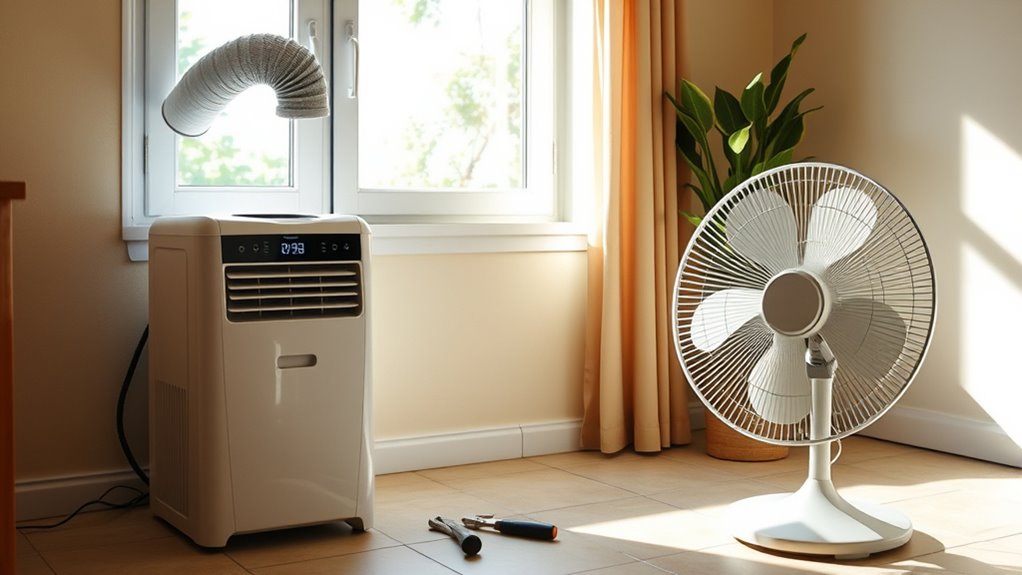
Portable air conditioners take more time and effort to set up, requiring venting and window clearance, while fans are ready to use instantly. Moving a portable unit is more cumbersome due to its size, whereas fans are lightweight and easy to reposition. Maintenance for portable ACs includes draining water and cleaning filters, but fans generally need only occasional blade or filter cleaning. Portable ACs are also more energy-intensive, which can impact overall convenience and operational costs.
Setup Complexity and Time
When comparing setup complexity and time, the ease of installing each cooling solution varies considerably. Portable air conditioners are the fastest, taking only 20 to 30 minutes since they’re self-contained and require just a power outlet and window venting. Window units are slightly more involved, needing about 1 to 2 hours for mounting and sealing. Split systems demand 4 to 8 hours, involving installation of indoor and outdoor units, plus refrigerant piping. Central systems can take 1 to 5 days, depending on ductwork and site conditions, often requiring professional HVAC technicians. Multi-zone or commercial setups may extend installation to weeks. Portable and window units need minimal tools and are DIY-friendly, whereas split and central systems require specialized skills, tools, and planning. Incorporating proper ventilation is also essential for efficiency and safety in any setup.
Portability and Moving Ease
While portable air conditioners offer the convenience of cooling on demand, their size and weight can make moving them around more challenging than fans. Typically weighing between 30 to 50 pounds, they require careful handling and space for placement, especially near windows for venting. Fans are much lighter, often under 10 pounds, and more compact, making them easy to carry and reposition in any room. They don’t need venting or special setup, giving you flexibility to use them anywhere with an outlet. Portable AC units also involve managing cords and vent hoses, which can restrict movement. Fans often feature built-in handles and lightweight frames, simplifying transportation. Additionally, portability is a key factor that influences how often you can reposition these cooling devices. Overall, fans are more convenient for frequent repositioning, especially in multi-room environments. Lightweight design makes fans easier to move regularly without requiring extra effort or equipment.
Maintenance and Cleaning
Maintenance and cleaning for portable air conditioners can be more involved than for fans, but with regular upkeep, they stay efficient and durable. You’ll need to clean filters every 2 to 4 weeks, either vacuuming or washing them thoroughly and drying completely. Some units have filters that require seasonal replacement. Twice per cooling season, you should vacuum the condenser coils after removing the back panel to prevent debris buildup. Managing condensation is also essential; drain tanks weekly and ensure drainage methods—manual, hose, or automatic—are functioning properly, especially in high humidity. Exterior surfaces should be wiped down periodically, and vents checked for dust. Unlike fans, portable ACs demand more effort to maintain, but proper care extends their lifespan and keeps them performing well. Regular maintenance not only preserves efficiency but also helps prevent costly repairs over time. Paying attention to air filter cleanliness can significantly impact overall performance and energy efficiency.
Noise Levels and Comfort
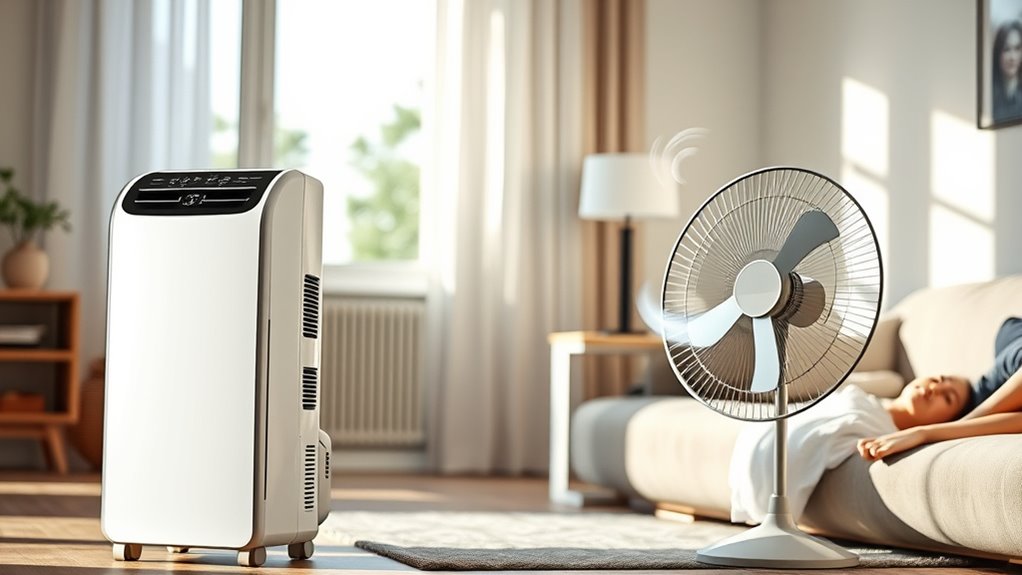
Noise levels play a crucial role in your comfort when choosing between portable air conditioners and fans. Portable AC units typically produce 50 to 70 dB, with some models operating as quietly as 38-44 dB—quieter than a whisper. Near the unit, noise can reach around 60 dB at maximum fan speed, but it drops to about 54-55 dB at 10 feet, yet remains noticeable. Fans generally run between 40 and 60 dB, often creating steady, predictable white noise that can be less intrusive. Decibel ratings help compare different models, and choosing a unit with a lower dB rating can significantly enhance comfort during long periods of use. Additionally, sound-dampening features in some models are designed to minimize noise further, improving the overall experience. Lower fan speeds and sleep modes on ACs can markedly reduce noise. Quiet models and sound-dampening features improve comfort. Consistent fan noise may be soothing, while high AC noise can disrupt rest.
Space Requirements and Portability
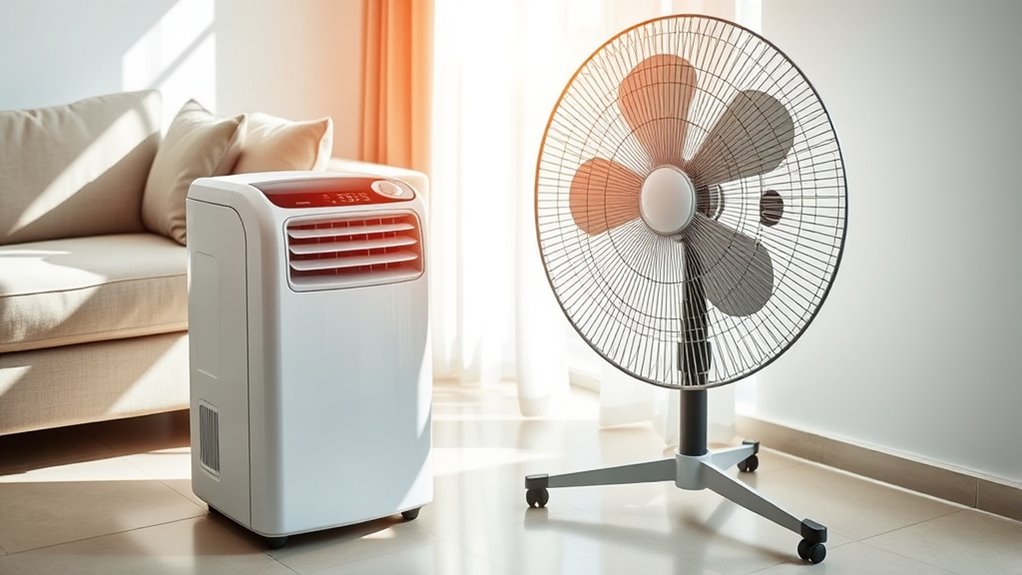
When choosing between portable air conditioners and fans, space requirements and ease of movement are key considerations. Portable AC units need enough room for installation, with at least 20 inches of clearance near a window for proper venting and ventilation. They also require space around the unit for airflow, usually a few inches on all sides, to prevent overheating and maintain efficiency. Larger units can be heavy—up to 50 pounds—limiting mobility, especially with the exhaust hose setup. In contrast, fans are lightweight, often under 15 pounds, and require minimal space—just a few square feet. They’re plug-and-play, needing no installation or venting, making them much easier to move around and store. Overall, fans offer superior portability and less space demand. Additionally, considering product weight and portability can help determine which cooling option best fits your living space and mobility needs.
Impact on Indoor Air Quality and Environment

Portable air conditioners mainly focus on cooling and dehumidifying the air, but they don’t substantially improve indoor air quality. They vent hot air outside, which can create negative pressure, pulling in unconditioned outdoor or adjacent air, possibly worsening indoor air quality. Additionally, they don’t effectively remove airborne particles, allergens, or pathogens, and neglecting maintenance like water tank emptying can lead to mold or bacteria growth. They also produce some levels of ozone or other emissions from refrigerants, which can impact indoor air quality if leaks occur. They generate noise pollution that affects comfort but not air quality. Regular upkeep is essential to prevent mold and bacteria buildup. Emissions from refrigerants or leaks can impact indoor air if not properly maintained. Modern portable AC units incorporate filters, but their effectiveness in air purification is limited compared to dedicated air purifiers. Compared to fans, portable AC units consume more energy and have a larger environmental footprint, but they offer some cooling benefits despite limited air purification.
Which Option Suits Different Summer Scenarios
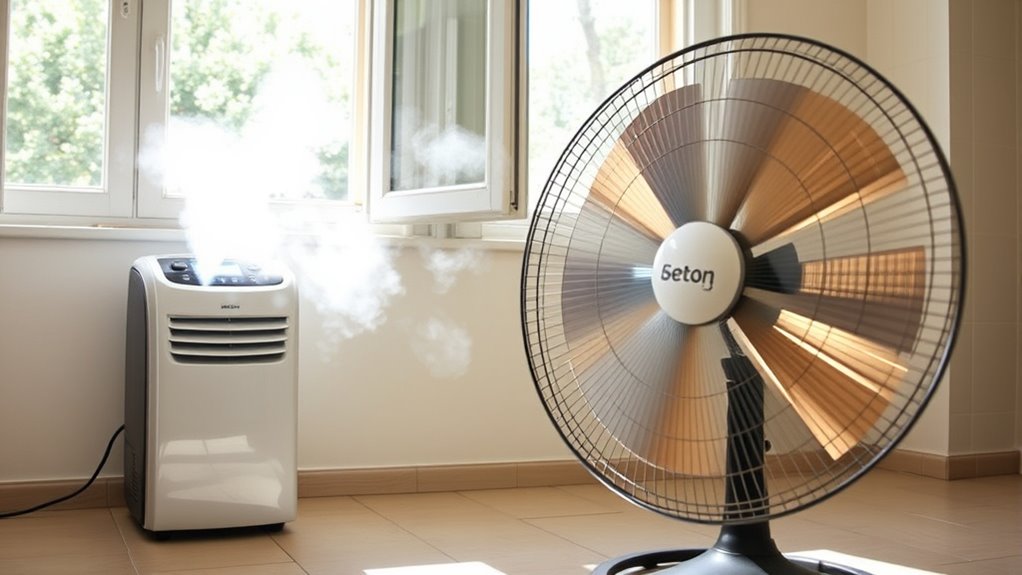
Choosing between a portable air conditioner and a fan depends largely on your specific summer circumstances. If you face high humidity, extreme heat, or need to cool a small space effectively, a portable AC is your best bet. It lowers room temperature and removes moisture, providing lasting comfort. However, keep in mind the higher energy costs and installation requirements. For dry climates, moderate temperatures, or when you want quick airflow, fans are ideal. They’re energy-efficient, portable, and easy to use, making them perfect for circulating air without lowering the temperature. Fans excel in well-ventilated spaces or during cooler nights, while AC units are better suited for intense heat or humidity. Consider your living situation, climate, and comfort needs to choose the best option for each summer scenario. Fans use about 30 times less energy than air conditioners, making them a more economical choice for many households. Additionally, understanding the cooling capacity of each device can help you make a more informed decision based on room size and cooling needs.
Frequently Asked Questions
Can Fans Help Reduce Indoor Humidity Levels Effectively?
Fans alone don’t effectively reduce indoor humidity because they only circulate air rather than remove moisture. They can improve comfort by speeding up evaporation, but they won’t lower humidity levels substantially. To truly reduce indoor moisture, you need tools like dehumidifiers or air conditioners that extract water vapor from the air. In humid climates, relying solely on fans isn’t enough; you’ll need a dedicated moisture control system for comfort.
Are Portable Air Conditioners Suitable for Small Apartment Spaces?
Portable air conditioners can work well in small apartments, especially if you need targeted cooling without permanent installation. You’ll find they’re compact and easy to move, but keep in mind they have limited cooling power and can be noisy. They’re best for small rooms or specific areas, offering convenient temperature control. However, they may use more energy and might not cool larger spaces effectively, so consider your needs carefully.
How Often Do Portable AC Units Require Maintenance?
Did you know regular maintenance can extend your portable AC’s lifespan by up to 30%? You should clean filters at least twice a month, especially during peak summer use. Schedule seasonal professional check-ups, typically in spring and fall, and inspect filters monthly. If you notice poor cooling, strange noises, or increased energy bills, it’s time for immediate maintenance. Staying proactive keeps your unit running efficiently and prevents costly repairs.
Do Fans Consume Less Energy Than Portable Air Conditioners in Extreme Heat?
You’re wondering if fans use less energy than portable air conditioners during extreme heat. Fans are far more energy-efficient, using about 1-2% of what ACs consume. They circulate air and create a cooling sensation without lowering room temperature. In extreme heat, ACs work harder and use notably more energy to cool the space, while fans keep running at a fraction of that energy, making them the more economical choice during intense heat.
Which Option Is Better for Sleeping Comfort During Hot Nights?
Imagine a peaceful night’s sleep as a calm lake, needing gentle ripples to soothe you. Fans provide that soft, consistent white noise, masking external sounds and offering a sense of comfort. However, they don’t lower the room’s temperature, which might leave you feeling too hot. Portable air conditioners actively cool and dehumidify, creating a more comfortable environment, especially on scorching nights. Choose based on whether you prioritize silence or temperature control for better sleep.
Conclusion
Choosing between portable air conditioners and fans depends on what you value most: comfort, convenience, or cost. If you want effective cooling, easy setup, and better air quality, a portable AC might be your best bet. If affordability, simplicity, and fresh air matter more, fans are ideal. Ultimately, it’s about matching your needs, enhancing your summer, and creating a space where you feel cool, comfortable, and cared for—because your comfort is worth it.
